This post originally appeared at https://will-law.org/blog-post-new-dpi-data-shows-alarming-enrollment-and-spending-trends/
Lost amongst the news of the Republican National Convention in Milwaukee, the Wisconsin Department of Public Instruction (DPI) released data on school district spending and enrollment around Wisconsin. The spending data is already significantly outdated—covering the 2022-23 school year that ended more than a year ago. Nonetheless, it does represent our best window into the current state of education in the state.
Among the key points:
- In the past five years, public school enrollment has declined by 4.79%, while choice enrollment is up 26.7%.
- Inflation-adjusted spending per student is down from 2 years ago, but up nearly $1,000 per student from 2010.
- Facilities spending accounts for a large share of the jump in spending—up 71% from 2010.
Enrollment Trends
Below is statewide enrollment in Wisconsin public schools over the past five years. In this time period, public school enrollment has declined by nearly 41,000, or 4.79%. Declining enrollment in Wisconsin public schools has accelerated since the COVID-19 pandemic. By comparison, for the time period between 2005 and 2019, the state only saw an enrollment decline of 2.19%. In the last five years, that rate of decline has more than doubled.
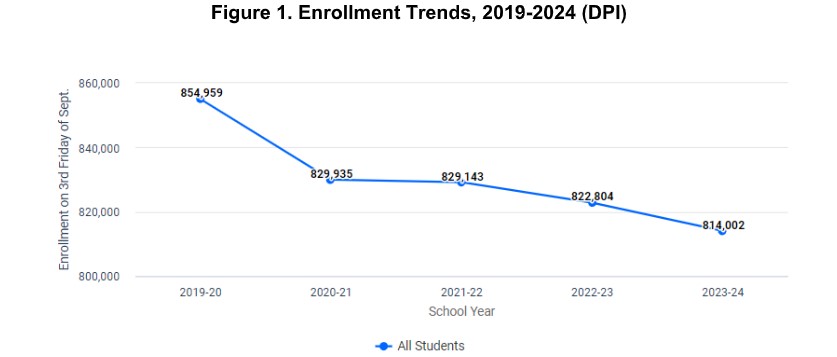
There are several reasons behind this decline. First, it is impossible to ignore demographic trends that have seen 1) fewer young people in Wisconsin and 2) fewer of those young people having children. According to data from the Department of Health Services, the number of births per 1,000 people has declined from 12.7 in 2003 to only 10.2 today.
But a significant number of Wisconsin families continue to make alternative choices when it comes to their children’s education. The figure below shows private choice and charter school enrollment around Wisconsin over the same time frame. Choice enrollment has grown by more than 11,000 students, with relatively steady increases each year. Over the past five years, even as public-school enrollment has declined by about 4.79%, choice enrollment has grown by about 26.7%.
Charter growth has been a bit more unsteady—seeing the largest spike in growth during the 2020-21 school year before leveling off. This is likely because charter schools include several virtual schools in Wisconsin, which parents likely flocked to during the pandemic as an alternative to traditional public schools unprepared for at-home learning.
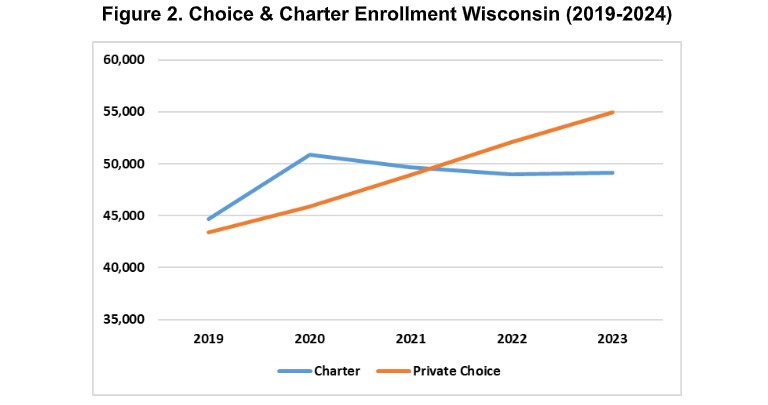
Which districts saw the biggest change? Table 1 shows the districts with the largest percentage increases and decreases in enrollment over the past five school years. Most of the districts on both ends of the spectrum could be characterized as small, rural districts. The most striking change is Brighton #1 that went from an enrollment of 208 to 113 between 2019 and 2023. This decline appears to have occurred in the last year, as enrollment in 2022 was 198. This may represent a data error DPI should investigate.
In terms of raw numbers, Milwaukee lost the most students overall by far at 7,819 (-10.47%), while McFarland gained the most at 563 (11.09%).
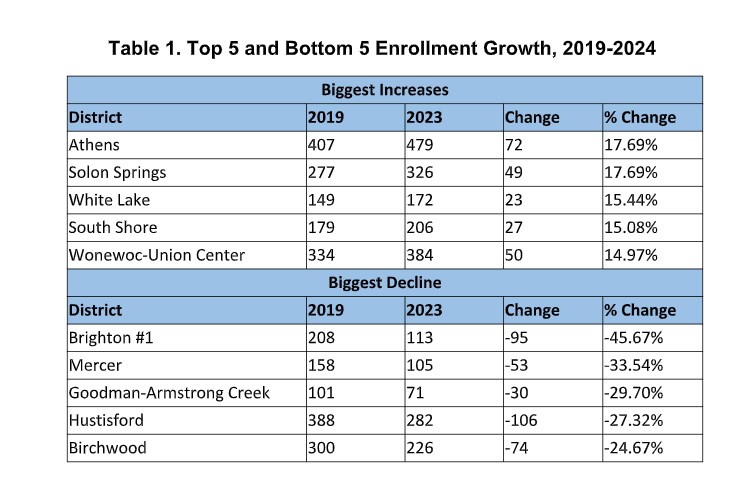
The Overall Spending Picture
It is important to note that this data is slightly different than what is reported on WILL’s School Scorecard, which is based on DPI’s revenue data that has not been reported yet. Adjusted for inflation, spending in Wisconsin school spending since 2019 has remained relatively steady between $17,000 and $18,100 per student. That said, spending relative to inflation has declined over the past couple years. There are a couple of potential reasons here. First, more than $2.3 billion in federal dollars were sent to Wisconsin school districts since the beginning of the pandemic. The last of that money is now drying up, with final expenditures required by September 30, 2024. A second possible reason is that spending in schools—much like most other aspects of the economy—has been unable to keep up with the massive inflation of the last two years. Nonetheless, claims that Wisconsin schools are ‘underfunded’ fall on deaf ears when one considers that costs per student are nearly $1,000 greater than they were 12 years ago in 2009.
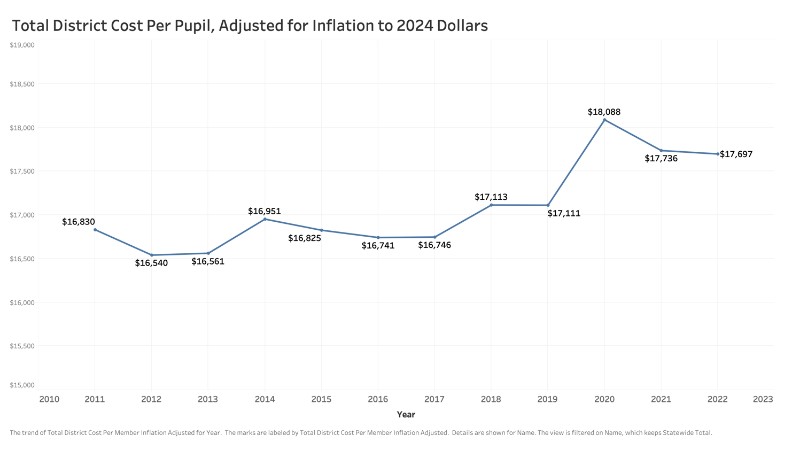
Where is that money going? DPI’s data includes a breakdown into various categories of spending. The pie chart below shows district spending in each category for the state.
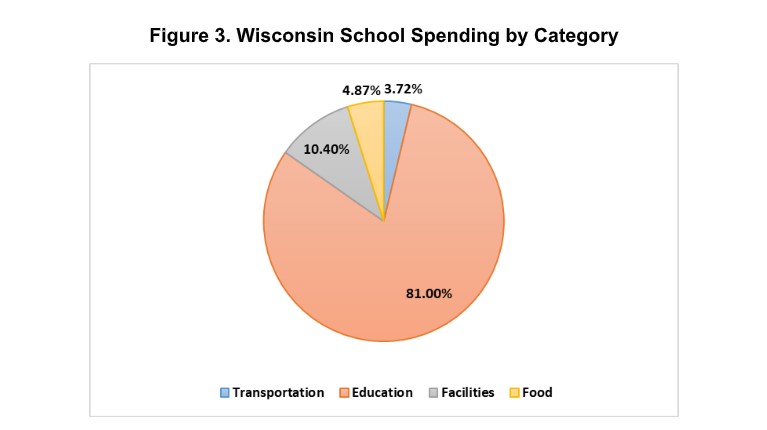
Perhaps encouragingly from this data, the vast majority of spending is on the “Education Cost per Member,” at more than 80%. The second largest category, facilities, only represents 10%. It is important to note, though, that many things that might be considered frivolous or wasteful can fall within the “Education Cost” bucket—even things like central office administration.
Category Breakdown
What categories are growing the fastest? The chart below shows the breakdown of spending in each category over the past 12 years. While education and transportation have held steady, growth in spending on food/community service and facilities has been more substantial. Since the 2009-10 school year, spending on food/community service is up approximately 10.65%. But a far more eye-opening cost increase has occurred on facilities costs—up 71% since 2009. A good portion of this might be explained by just general increases in the costs of construction, chronicled in a 2022 WILL report. But some of it may also reflect an increase in the number of large-scale funding projects that districts are undertaking with referendum dollars. For instance, in just the last two years, Waunakee and Appleton have passed referenda that put taxpayers on the hook for more than $125 million each. This fall, Arrowhead will ask voters for a staggering $260 million in bonds, and Madison Metropolitan will ask for more than $500 million for facilities (along with more than $100 million for operations).
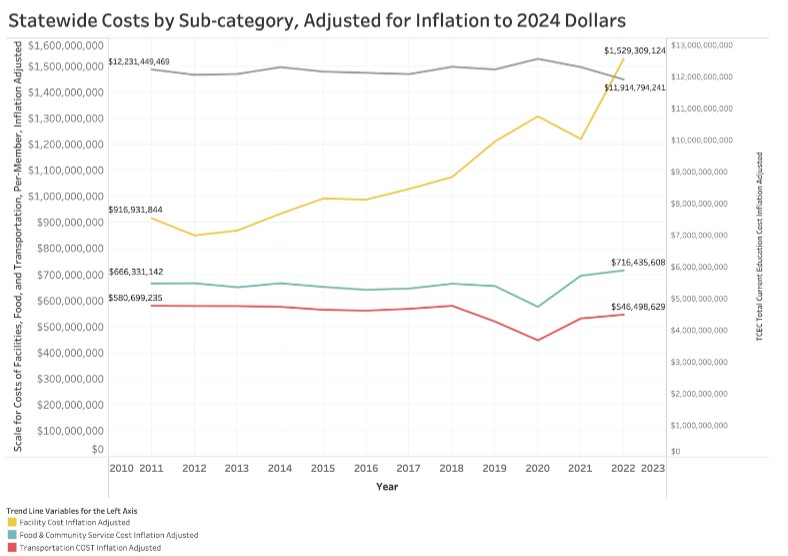
The figure above includes a dropdown that allows readers to explore how costs have gone up in their respective districts, which can vary extensively between districts. For example, districts like Cudahy that don’t provide bussing to regular education students are only spending $190 per member within the transportation bucket. At the other end of the spectrum, districts like North Lakeland are spending just short of $2,000 per student to provide transportation. North Lakeland is a rural district near the Michigan border where bussing students will necessarily be more expensive than in compact, suburban communities like Cudahy.
Where is Spending Growing?
Overall, after adjusting for inflation, 283 districts are spending more than they were in 2009-10, while 136 are spending less (a few districts were consolidated or went away during this time frame—they are not included). The districts that saw the biggest increase in spending over this time are included in the chart below.
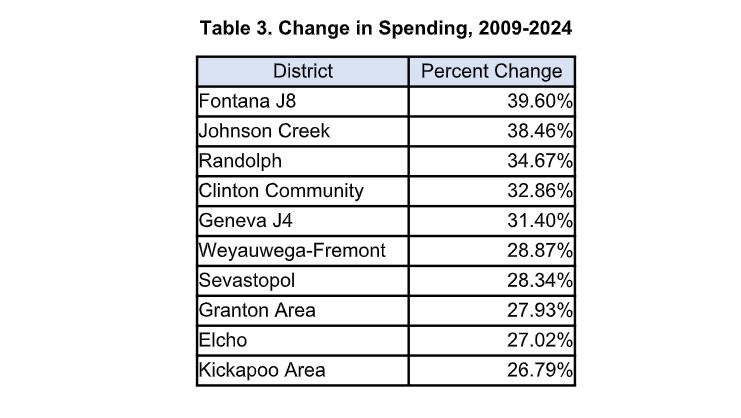
Though falling just out of the top ten here, it is worth noting that some school districts with large, upcoming referenda have already seen increases in spending in the last decade that exceed what the state as a whole has seen by a significant amount. Madison Metropolitan—which has proposed more than $600 million in new referendum spending has seen spending growth of 13.27% after adjusting for inflation since 2009. While Wauwatosa which will ask voters for more than $124 million between two referenda this fall—ranks 12th in the state in the growth in its spending since 2009 with a growth of 25.48%.
Conclusion
The current picture of education in Wisconsin is one of high spending and declining enrollment. We continue to spend more on education after adjusting for inflation than we did a decade ago, yet school districts continue to go to referendum and complain to the state for more money despite this reality. In the long run, school districts will have to accept that less money will be coming into their coffers unless there is an unlikely spike in enrollment.

Will Flanders, PHD
Research Director
Flanders@will-law.org
The post Blog Post: New DPI Data Shows Alarming Enrollment and Spending Trends appeared first on Wisconsin Institute for Law & Liberty.